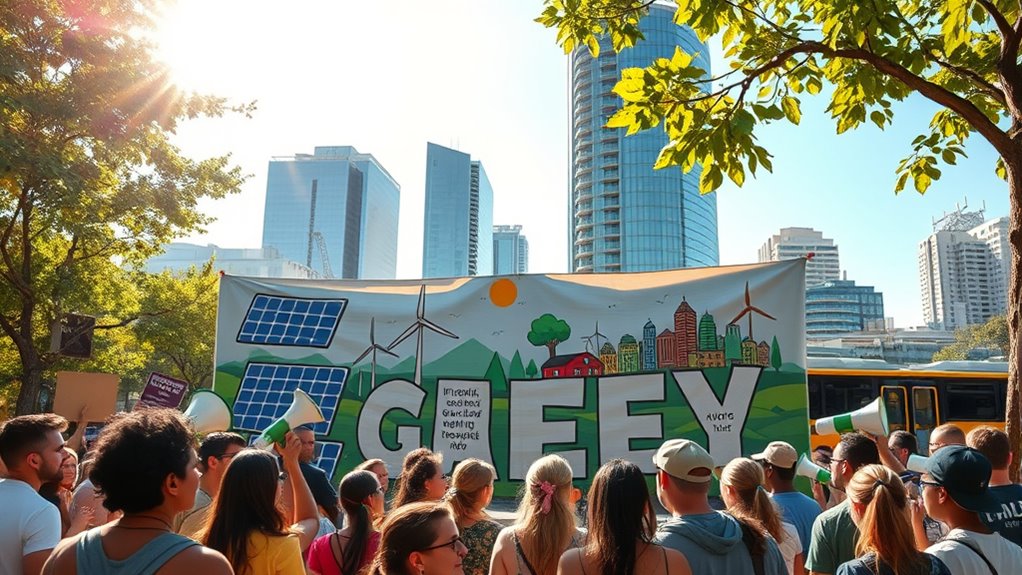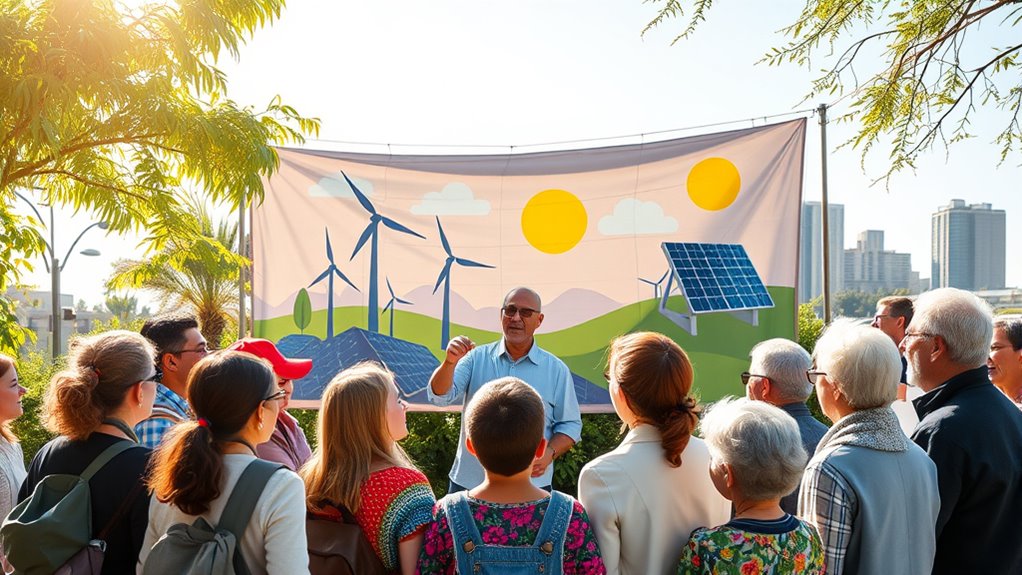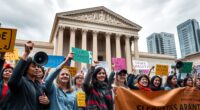The Green New Deal and similar bold proposals aim to overhaul our economy by investing heavily in renewable energy, creating millions of good-paying jobs, and making systemic reforms to fight climate change. They focus on shifting from fossil fuels to sustainable sources like wind and solar while promoting social equity and community resilience. If you want to explore how these ambitious plans blend environmental goals with economic revitalization, there’s much more to uncover ahead.
Key Takeaways
- The Green New Deal aims to overhaul energy systems, create jobs, and address climate change through bold, systemic reforms.
- It emphasizes transitioning to renewable energy sources like wind, solar, and geothermal, reducing reliance on fossil fuels.
- The proposal links environmental sustainability with economic reform, promoting equitable job creation and community resilience.
- Critics raise concerns about costs and feasibility, but supporters argue long-term benefits include a sustainable, resilient economy.
- Other bold proposals focus on integrating climate action with infrastructure upgrades, social safety nets, and innovative green technologies.

While the Green New Deal has generated both excitement and debate, its core aim is clear: to address climate change aggressively while creating economic opportunities. At its heart, the proposal seeks to overhaul existing climate policy, emphasizing sustainable energy, green infrastructure, and job creation. You’re encouraged to see it as a thorough approach that links environmental goals with economic reform—an effort to modernize industries and reduce emissions simultaneously. It’s not just about protecting the planet; it’s about transforming the economy to be more equitable and resilient.
The Green New Deal aims to fight climate change while boosting economic growth and building a more equitable future.
The Green New Deal advocates for bold investments in renewable energy sources like wind, solar, and geothermal. By doing so, it aims to replace fossil fuels, which are major contributors to climate change. This shift could drastically cut greenhouse gas emissions while opening up new sectors for employment, from manufacturing to installation and maintenance. You’ll notice this approach aligns with a broader climate policy that prioritizes sustainability and innovation. Instead of incremental changes, it pushes for rapid, systemic reform that can have a tangible impact within a relatively short timeframe.
Economic reform is a fundamental part of the Green New Deal. It recognizes that combating climate change requires more than technological advancements; it demands a rethinking of economic structures. You’re encouraged to see it as an opportunity to address income inequality, create good-paying jobs, and support communities disproportionately affected by environmental degradation. The proposal calls for significant public investments to stimulate economic growth, with a focus on ensuring that the benefits are widely shared. It emphasizes a transition that’s just, providing workers with retraining programs and new skills to thrive in the green economy. Additionally, incorporating cutting-edge technology can enhance the implementation of eco-friendly solutions and make the transition more efficient.
Critics argue that such sweeping reforms could be costly or unrealistic, but proponents believe that the long-term benefits outweigh the initial investment. They see this as a chance to reshape the economy into one that’s sustainable, equitable, and resilient against future crises. The Green New Deal’s climate policy isn’t just about reducing emissions; it’s about embedding environmental responsibility into every facet of economic reform. This includes policy measures that support clean energy innovation, infrastructure upgrades, and social safety nets, all working together to build a more sustainable future.
In essence, you’re looking at a proposal that aims to combine climate action with economic revitalization. It recognizes that the two are interconnected—solving one requires rethinking the other. By pushing for bold, systemic changes, the Green New Deal aspires to create a future where economic growth and environmental health go hand in hand, ensuring a more sustainable and equitable world for generations to come.
Frequently Asked Questions
How Would the Green New Deal Impact Job Creation?
You’ll see that the Green New Deal can boost job creation by generating green jobs across renewable energy, transportation, and infrastructure sectors. It promotes economic growth by investing in sustainable projects that require a skilled workforce. As a result, you’ll likely experience more employment opportunities, especially in clean energy industries, helping communities thrive while reducing environmental impact. This approach aligns economic development with environmental sustainability, benefiting both workers and the planet.
What Are the Funding Sources for These Proposals?
You might be surprised to learn that funding these bold proposals relies on smart fiscal strategies and diverse funding mechanisms. Governments can allocate funds through increased taxes on the wealthy, closing tax loopholes, or implementing carbon pricing. Additionally, public-private partnerships and green bonds attract private investments. These strategies work together to generate the necessary resources, ensuring the projects move forward without overburdening taxpayers.
How Do These Proposals Address Climate Justice?
You see these proposals aim to promote climate justice by prioritizing climate equity and social inclusion. They focus on supporting marginalized communities most affected by climate change, guaranteeing fair access to clean energy, jobs, and resources. By addressing systemic inequalities, these initiatives help create a more just transition, empowering everyone to participate in building a sustainable future. This approach guarantees no one is left behind in the fight against climate change.
What Are Potential Economic Risks of These Plans?
You might worry about the fiscal implications of these plans, as they could require significant government spending or new taxes, impacting budgets. Market volatility is another concern, since large investments in green technologies could cause fluctuations in financial markets. While these plans aim for long-term benefits, you should consider the short-term economic risks, like increased debt or instability, that might arise as governments and industries adjust to these bold changes.
How Do These Proposals Compare Internationally?
Imagine the world’s response to bold climate plans—are they a blueprint or a warning? You see, international comparison reveals many countries adopting aggressive global policies, pushing renewable energy and green innovation. Some lead with ambitious targets, while others lag behind, risking economic and environmental futures. These differences highlight how, in the global race against climate change, bold proposals can either propel nations forward or leave them behind.
Conclusion
So, now that you understand the Green New Deal and other bold proposals, it’s clear they aim to tackle climate change while creating jobs and promoting equity. Will you support these ambitious plans to build a sustainable future? If you believe in taking bold action for change, now’s the time to get involved and make your voice heard. Together, you can help shape a healthier planet for generations to come.









